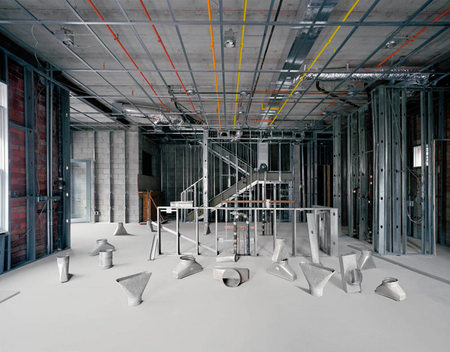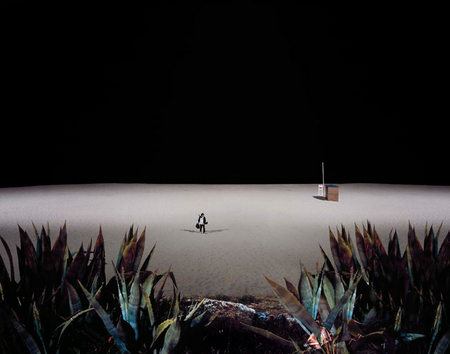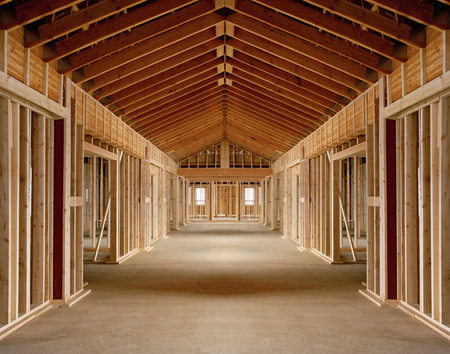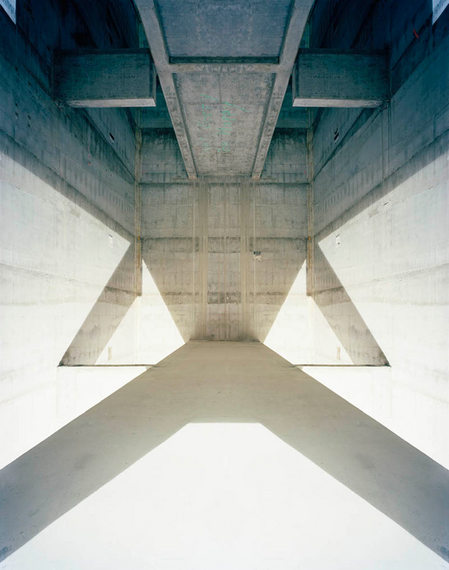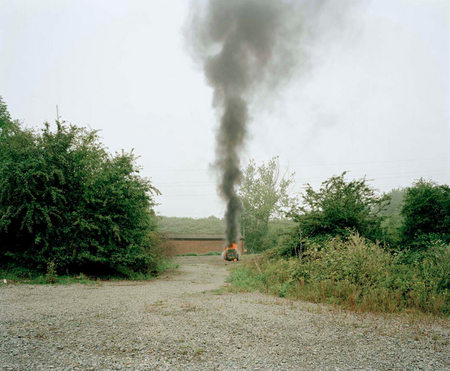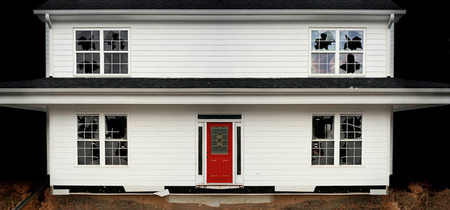Spotlight: Edgar Martins explains his creative process
This post complements Edgar Martins’ How can I see what I see, until I know what I know?. For these images Martins explains his thinking/work behind them. Click on the images to see larger versions. All images are © Edgar Martins - Jörg Colberg
Untitled, from the series ‘Ruins of the Gilded Age’ 2008 (Arizona, USA)
C-type print, 98x127cm & 40x52cm
Edition of 5
© Edgar Martins
The constructions in this image are restricted to some of the pipe work in the ceiling as well as the objects in the foreground which were simply increased in number and, of course, in some cases mirrored.
My starting point for this construction was a simple statement which I once read: ‘only a bad architect relies on symmetry; instead of symmetrical layout of blocks, masses and structures, Modernist architecture relies on wings and balance of masses’.
My intention was to draw on references form Modernism Art, thus also alluding to the wider concerns in my work, particularly with respect to the impact of Modernism on the environment.
Untitled, from the series ‘The Accidental Theorist’ 2007 (Portugal)
C-type print, 66x83cm & 98x127cm
Edition of 5 & 3
© Edgar Martins
This project defined a way of working which has shaped my practice.
This work has two distinct phases: the photographs which I produced prior to 2007 and the images which followed.
With regards to the images produced post 2007, these deploy a different approach. I produced a limited selection of photographs which further explore the idea of construction and theatricality. The primary objective was to further enhance the temporal experience of these images. I have always made a conscious attempt to differentiate between the two different approaches publicly.
Both myself and the editors of ‘Topologies’ felt that these images should not be included in the publication given the different approach which was used.
However, I have since sought to include at least one image from this latter phase in the exhibitions of this work which have taken place since early 2008. Much like the fires in the ‘Black Holes’ project or the obvious symmetries at play in others, these images play a specific role.
For two years I had longed to produce a reasonably long exposure of an individual in this stretch of coastline. However, due to the approach which I had devised (solely portraying found scenario), I soon realised that photographing a single person in the less well light beaches, at the proposed time of night, and for an extended period of time, would simply not be feasible. Even if staged I did not believe the person would be able to convey all of the things which I had envisaged he/she would. However, In September 2007, through a chance encounter, I was finally able to produce such a photograph.
Stepping out of downtown Lisbon’s underground station I came across a street performer, a so called ‘human-statue’, that seemed connected to my images in more ways than I could ever have imagined.
His black coat, pants, hat and tie looked as though they were being blown back by a strong gust of wind. This effect was no doubt shaped by a wire structure sewn into the lining of the clothes. His facial expressions, hairstyle and stature, supported by the briefcase he was holding spoke of displacement; of a person trapped in a space of permanent arrivals and departures. There was a magical sense of movement to his performance. Yet, he was as still as the umbrella which I had photographed the night before in one of these beaches.
For years I had sought to represent movement in still and inanimate objects, highlighting photography’s inability to capture or represent time.
In front of me was an individual who had mastered the art of conveying time through body language.
In an uncharacteristic move for me, I approached this individual; not only interrupting his performance but also proceeding to tell him all about my project.
We agreed to meet that same evening at a beach in the outskirts of Lisbon. I had asked him to produce two 30 minute performances at that location, from 10 PM onwards.
I did not know if he’d show up, given the casual nature of our agreement, but luckily he adhered to the schedule. Bound by a shared understanding, this is how Pian and I produced this photograph.This photograph represents more than a mere individual performance for me. My work is generally produced in peripheral regions, in spaces where there is a dialectic of stasis and flux that is in a constant state of uncertain transformation. In this landscape of uncertainty, where everything expresses contingency, and where space and time are about to simmer and disperse, a lasting friendship was forged. This is the only landscape that survives our absence.
Untitled, from the series ‘Ruins of the Gilded Age’ 2008 (Montana, USA)
C-type print, 98x127cm & 40x52cm
Edition of 5
© Edgar Martins
Similarly to the photograph of a wooden house interior, shot on the outskirts of Phoenix, which sparked the current debate, I produced other mirrored interiors, which I submitted to the New York Times magazine.The structural and cosmetic properties of this image are strikingly symmetrical. It explores an imaginary sense of “wholeness” to the experience of a fragmentary reality.
Untitled, from the series ‘Ruins of the Gilded Age’ 2008 (Nevada, USA)
C-type print, 98x127cm & 40x52cm
Edition of 5
© Edgar Martins
The left hand side of the image was mirrored on the right hand side. Paradoxically, the original image was almost identical to this photograph, the only difference being the shadow on the ground which wasn’t as pronounced. My objective was to highlight the ‘V” shape on the ground. It occurred to me whilst producing this project that many of the developments which I had visited had single letters or various coded signs spread throughout them. These would often be painted on the doors of abandoned residential developments, on the outside perimeter fences of commercial complexes or in this case on the bare walls of the building. It reminded me of terminology and markings which were used on the house fronts in the aftermath of Katrina.
I was therefore contemplating if the reference to such symbols might resonate with the viewer at a subconscious level.
The symbol ‘V’ is more traditionally associated to ‘Victory’ but also to ‘Versus’. Following this train of thought we could also associate it to ‘Volt’, ‘Velocity’ (these being elevator shafts).
The symbol ‘V’, in itself, can also be understood as an acronym for symmetry.
I have always sought to explore multi-layered images. In my view this is one of the ways in which Photography can overcome the single-frame’s limitations.
A symbolic meaning is selected by a common lexicon of symbols, which seeks out the viewer.
The obvious meaning, as Barthes argues, overwhelms ambiguity.
The obtuse meaning, on the other hand, ‘has something to do with disguise’. It comprises ‘a layering of meanings which allows the previous one to subsist, as in a geological formation; to speak the contrary without renouncing the thing contradicted’ (Barthes, Roland, The Responsibility of Forms, University of California Press, published by Farrar, Starus & Giroux, 1991). The symmetrical facet assumes this function.
Untitled, from the series ‘Black Holes & Other Inconsistencies’ 2003 (Portugal)
C-type print 40x52cm
Edition of 5
© Edgar Martins
This fire was also staged in a middle of a dark road in Portugal. It was lit by a single flash. The images of fires were only conceived once the project was nearing completion. I felt anxious that the reader would not view the book and the work (moreover its production) as an inter-related process. I did not want it to be understood as a compilation of disparate photos taken in different locations and at different periods of time. It was therefore important to create a set of images which accentuated the ambiguity of the work and which positioned the author ‘in the present tense’ in relation to the process of production of the images and rationalization of the work.
In Bachelard’s The Psychoanalysis of Fire, the phenomenon of fire is presented as the prime element of reverie, an object of consuming essence where one is able to see oneself mirrored. A metaphor for performance, fire is also associated to the process of change - Bachelard maintains that ‘all that changes quickly can be explained by fire’.
No digital processes were involved in the conception of this photograph.
Untitled, from the series ‘The Diminishing Present’ 2006 (UK)
C-type print, 98x127cm
Edition of 5
© Edgar Martins
Apart from three symmetrical constructions included in this body of work it portrays solely found scenario. No digital processes were involved in the conception of this photograph.
The Diminishing Present assesses how various natural spaces have been forced to conform to increasingly urban and artistic ideals, adopting the codes and language that it yields.
At times the work seems to question whether space as a totality escapes the perception of the individual; whether our experience of place, as a whole, has become an incipient forum of disruptive experiences and expression; whether the movement of information and people and the commodification of cultural forms outlines a unique body of flow and false consciousness.
But at other times it simply proposes that we are no longer mere transients.
The Diminishing Present is a journey of recognition: the city and, in a broader sense, space, as our object of understanding is changing and because of this one needs to find a new critical language that supports it, and a new system of knowledge from which to derive our glossary of life.
Untitled, from the series ‘Ruins of the Gilded Age’ 2008 (Georgia, USA)
C-type print, 98x254cm
Edition of 5
© Edgar Martins
This panoramic photograph was conceived by mirroring the same image and making subtle digital alterations. As with most of the visual hyperbolic statements which pervade my work, the symmetry is not subtle in its psychological nuances. My overall intention was to replicate another image which I took of this house, where the sunset was reflected on one of the top windows only.
The digitally constructions have an important role in the project.
Fragmented spaces become metaphors for one’s fragmented memories.
These houses are also a psychological interior.
